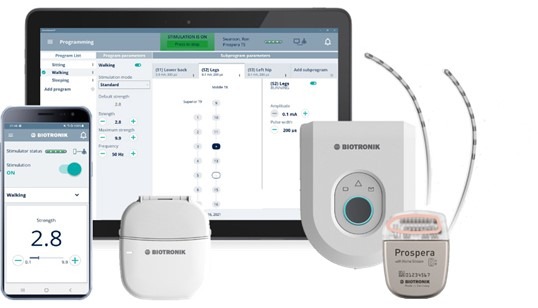Spinal Cord Stimulation Systems
Intended for chronic, intractable back pain
What Is an SCS System?
A spinal cord stimulation (SCS) system is a medical device used to manage chronic pain by delivering electrical impulses to the spinal cord. The system typically consists of several components:
Implantable Pulse Generator (IPG)
This is the main component of the SCS system and is surgically implanted under the skin, usually in the lower abdomen or upper buttock region. The IPG generates electrical pulses based on the settings programmed by the patient or healthcare provider.
Leads
These are thin, insulated wires that are also surgically implanted and positioned along the spinal cord. The leads carry the electrical impulses from the IPG to specific areas of the spinal cord responsible for transmitting pain signals.
External Programmer
Patients and healthcare providers use an external programmer to adjust the settings of the SCS system. This programmer communicates with the IPG through radiofrequency signals and allows for customization of parameters such as pulse amplitude, frequency, and duration.
Remote Control
Some SCS systems come with a handheld remote control that allows patients to turn the device on or off, adjust stimulation settings, and even create different programs for different activities or times of day.
Charging System (Optional)
In the case of rechargeable IPGs, a charging system is included to recharge the battery within the IPG. This may involve an external charging device that is placed over the implanted IPG and connected to it wirelessly or via a charging cable.
Functionality
The functionality of an SCS system involves delivering electrical pulses to the spinal cord, which modulate the transmission of pain signals to the brain.
The electrical stimulation interferes with the perception of pain, providing relief to individuals suffering from chronic pain conditions such as failed back surgery syndrome, neuropathic pain, complex regional pain syndrome, and others.
By adjusting the parameters of stimulation, patients can optimize pain relief while minimizing side effects such as tingling or discomfort.
